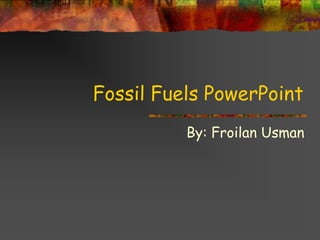
Fossil fuels power point
- 1. Fossil Fuels PowerPoint By: Froilan Usman
- 2. What are Fossil Fuels? Fossil Fuels are fuels formed by natural resources, these fuels are formed in the Earth over millions of years from decayed organisms and produce carbon dioxide when burnt.
- 3. What are different types of Fossil Fuels? There are three types of Fossil Fuels, which can all be used for energy; coal, oil and natural gas.
- 4. How Coal is formed? Coal is formed over millions of years by decay of land vegetation. When layers are compacted and heated over time, deposits turned into coal.
- 5. Different stages of coal formation There are four stages of coal formation; Lignite, Sub Bituminous, Bituminous and Anthracite. Lignite deposits are the youngest of the coal types and have undergone the lowest intensity of heat and pressure. Sub bituminous coal contains less water and is therefore harder than lignite. Bituminous coal is heavily utilized for energy in power plants and for the production of steel. Anthracite coal is known to be the cleanest burning coal but is one of the rarest, being found mainly in limited reserves in Pennsylvania.
- 6. How is coal used as a fossil fuel? Coal is usually extracted in mines. Since the middle of the 20th century, coal use has doubled. Since 1996 its application is declining again. Many developing countries depend on coal for energy because they cannot afford oil or natural gas. China and India are major users of coal energy because like I said they cannot afford oil or natural gas.
- 7. How is oil formed? Oil is a liquid fossil fuel that is formed from the remains of marine microorganisms on the sea floor. After millions of years the deposits end up in rock and sediment where oil is trapped in small spaces. It can be extracted by large drilling platforms
- 8. How is oils used as a fossil fuel? Oil is the most widely used fossil fuel. Crude oil consists of many different organic compounds which are transformed to products in a refining process. It is applied in cars, jets, roads and roofs and many other.
- 9. How is natural gas formed? Natural gas is a gaseous fossil fuel that is versatile, abundant and relatively clean compared to coal and oil. Like oil, it is formed from the remains of marine microorganisms. It is a relatively new type of energy source. Until 1999, more coal was used than natural gas. Natural gas has now overtaken coal in developed countries. However, people are afraid that like oil, natural gas supplies will run out.
- 10. How is natural gas used as a fossil fuel? They are usually used for electricity, to create glass, paper, and steal. Most people use it to heat their homes.
- 11. What are Refineries and why are they important to the production of Fossil Fuels? Refineries are factories that plan to separate the various components present in crude oil and convert them into usable products or feedstock for other processes.
- 12. Exon Valdez Oil Spil The main cause of the spill was the failure of the third mate to properly maneuver the vessel because of fatigue and excessive workload. Over 6,700,00 million gallons of oil was spilled. Ten years after the spill it is clear that many fish and wildlife species injured by the spill have not fully recovered. It is less clear, however, what role oil plays in the inability of some populations to bounce back. Hose spraying seawater were used to flush oil from shorelines. The released oil was then trapped with offshore boom, and removed using skimmers, vacuum trucks was useful for thick layers of oil and boom sorbent, snare, pompoms. For hard to reach areas, or locations with weathered oil, heated seawater was used to flush oil from the shoreline.
- 13. Deep water horizon Catastrophe The Deep water Horizon oil spill is an ongoing massive oil spill underwater in the Gulf of Mexico Started on April 20, 2010. The fire aboard the Deepwater Horizon reportedly started at 9:45 pm. survivors described the incident as a sudden explosion which gave them less than five minutes to escape as the alarm went off.